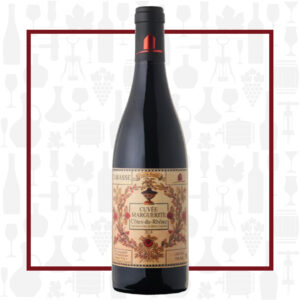Cellar Profile
The winery and estate sit between the towns of Séguret and Sablet, a half-hour drive from iconic Châteauneuf-du-Pape. Under vine for over 600 years, the property has been lovingly cared for by the Baudry family since 2012. Approximately 15 sustainably-farmed hectares in the towns of Séguret, Sablet and Gigondas are planted with Syrah, Grenache, Mourvèdre, Counoise, Carignan, Clairette and other local white varieties. These are some of only 16 Southern Rhône communes which may use their name along with the Côtes-du-Rhône Villages appellation. The small plots are surrounded by hedges and trees that protect the vines from the cold Mistral which can blow violently from the north. The Mediterranean climate assures plenty of warmth and sunshine during the growing season, but the nearby sea and stiff evening breeze ensure a broad diurnal shift that retains acidity and freshness in the wines. The pebbled soils are a mix of clay, sand and, most importantly, limestone.
Region
The Southern Rhône has been contiguously planted since 600 BC and is one of the largest and most important wine regions in France in terms of volume. There are over 1800 individual wineries and over one hundred co-operatives here. The area offers juicier, headier and less complicated wines than the north, where you’ll predominantly find structured Syrah and viscous, intense, aromatic Viognier. In the south, there’s a veritable cornucopia of allowable grapes to choose from, including Syrah, Grenache, Mourvèdre, Cinsault and Carignan in red, and Clairette, Viognier, Picpoul, Muscat and Grenache Blanc in whites. The most notable southern appellation – Châteauneuf-du-Pape — allows up to 19 different grape varieties to be used in the blend! Wine made from grapes grown throughout the Rhône region will have the basic “Côtes du Rhône” AOC on the label, while wines produced from designated areas that have attained a higher level of ripeness and maturity of grapes before harvest can use the “Cotes du Rhône Villages” designation.Some will have the name of the Village they are from, such as “Côtes du Rhône Sablet”. More than 95 villages make up the Côtes du Rhône Villages appellation area. There are also 20 different communes within the Rhône Valley (North and South) that have been designated as producing wines of exceeding quality called “Cru”. In the south, these include Châteauneuf-du-Pape, Rasteau, Gigondas and Vacqueyras. The climate in Southern Rhône is Mediterranean, with intensely hot summers and mild, wet winters. High daytime temperatures are moderated by cooling sea breezes and by the intense cold wind they call “Le Mistral” that rips its way through the valley to empty out into the sea. The resulting precipitous temperature drops help ensure some acidity remains in the wines, despite the sometimes elevated alcohol levels.
Vineyard
The Estate vineyards have been farmed since the 14th century. These old vines are planted in sandy soil sitting on top of calcareous rock and a good amount of limestone. They are sustainbly-tended and surrounded by high hedges that help moderate the intense Mistral wind.
Varieties
Grenache, also known as Garnacha in Spain and Cannonau in Sardinia, is one of the most widely-planted grape varieties in the world. It is a solid choice for wineries looking for high-yielding vines of decent quality, but is best grown in warm, dry conditions where care is taken to manage canopy and reduce yields. Thin-skinned and extremely vigorous, the root systems of Grenache are strong and can survive in dry climates with little irrigation, where limited yields and thickened skins result in wines with better structure, deeper pigment and tannic grip. Where there is abundant water, the wines will tend to be paler, with softer tannins. It is late-ripening — generally one of the last off the vine — often producing wines high in alcohol. Grenache is one of the most important varietals in the Southern Rhône and is a fabulous blending partner with Syrah and Mourvèdre. The resulting wines are commonly called “GSM” blends. It also plays a major role in key Spanish appellations such as Navarra, Aragon and Priorat.
Winemaking
Fruit is de-stemmed and crushed into stainless steel. The juice macerates on its skins for 16 days, with a fermentation from selected yeasts. The wine is aged in stainless for a year, to retain primary fruit and freshness, before being bottled.
Tasting Notes
Soft and approachable, with red berry and spice on the nose. The palate is rich and supple, with layers of red berry, currant, vanilla and crushed violets. Gentle acidity helps to balance the generous fruit. Serve at cellar temperature with roasted meats and vegetables or with umami-rich Asian cuisine.

 info@buyersandcellars.ca
www.buyersandcellars.ca
info@buyersandcellars.ca
www.buyersandcellars.ca